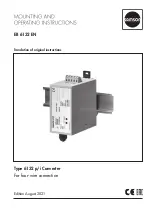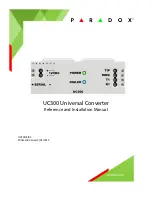
User’s Manual—Please read before using this equipment.
0
InsTALLATIon—ConneCTIng An InverTer
General Information
This inverter must be mounted in a dry, cool and dust free environment.
If installation is on a wall or bulkhead, the inverter should be mounted horizontally. Vertical
mounting allows dust and objects to fall into inverter vents.
Loose cable connections can result in a severe voltage drop that can damage connectors,
conductors, and insulation and can cause sparking. A reverse polarity connection will blow
fuses in the inverter and can permanently damage the inverter. Damage caused by reverse
polarity will void the warranty.
There are multiple sets of DC input terminals to reduce the need for larger gauge cables. All
DC terminals are threaded studs that have metal washers and nuts. Make sure that you have
the proper sized socket wrenches to tighten terminal connections when so directed. The table
below indicates the how many sets of cable terminals to use for different power levels. One
terminal set is any positive and any negative terminal.
NOTE: No single terminal can carry more current than described in the table that follows:
Watts
2500
5000
7500
0000
Terminal Sets
2
3
4
All cables must be made of stranded, insulated copper wire. Measure the round trip length
of cable needed. Round trip is the distance from the negative battery bank terminal to the
inverter and back to the positive terminal of the battery bank. Use a length of string and
follow the route the cables will follow. Measure the length of string and then determine the
correct gauge cable required for the power level and total distance. Appendix A has a table
that relates cable length and gauge for your inverter. Measure all terminal stud diameters
that are to be connected to cables. Obtain ring terminals that fit the cables and terminal
studs. Be sure the ring terminals can carry the current required.
Ground Terminal Wire Requirements
Use a minimum of 6 gauge stranded wire for enclosure ground wire. Connect this to the
chassis of your vehicle or to the grounding system in your boat. In a city, the ground wire
can connect to a metal cold water pipe that goes underground. In remote locations, the
ground wire can be connected to an “earth ground”. This can be an attachment to a 6 foot
long copper clad metal rod driven into the ground. In the unlikely event of a short circuit,
operating the inverter without proper grounding can result in electrical shock. Do not directly
connect this ground to the negative terminal on the inverter.
Cable Preparation
Strip all cable ends to allow crimping of Ring Terminals.
Crimp appropriate sized ring terminals onto all cable ends including fuse holder
cable ends.
Connect the fuse holders to the long positive (+) cable terminals.
.
2.
3.
© 2009 Wagan Corporation.
All Rights Reserved.
Wagan and wagan.com are trademarks used by Wagan Corporation.






































